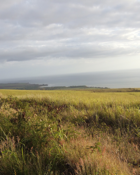Teaching Philosophy and Materials

Hart Crane, "Voyages," "Ave Maria," and "Cape Hatteras"
We began our discussion on Hart Crane by referring to Brian Reed's excellent exegesis of "Voyages." Reed offers a careful, and humorous, explanation of Crane's poem as a love poem that extolls love between two men, replete with verse communicating love's ability to "swell with passion" as it hits one like a "tsunami," "overwhelm[ing] every objection and reservation" (Reed par 2). "Voyages" was inspired by Crane's love for Emil Opffer, a sailor, who, because of the very nature of that profession, is peripatetically on "voyages," coming and going. This sets up the drama of the poem. It also unleashes the poem's momentum. This seafaring serves as a metaphor throughout the poem for the nature of love. Reed also comments on the amplitude of Crane's language in the poem, which isn't always accurate but which can be summed up as a "burb[ling] [of] what Roland Barthes calls le discours amoureaux, the lover's discourse" (Reed par 11). Remember the funny example Reed offers of Crane's inaccuracy.
Take a look at the rather tidy stanzas of "Voyages." On what do each of the six sections focus? How are they structured, poetically? We see a few lines that, on the page, are broken. We talked about this in class, when I explained to you that often significance lies in a poet's departure from conventional line structure. Look at two lines like these (you'll see them in Section III): "Your body rocking! / and where death, if shed, " -- I have cut these lines off from their surrounding context, so they make no sense here, but I wanted to call your attention to the fracture. Why does Crane do this and why here? There are two more lines that are remarkable for their creation through this kind of break. Find those lines and see why that break is significant to the poem.
Now, as for The Bridge, we all struggled with the section "Ave Maria." I told you it was very common to do so. But what can we nevertheless get out of it? How does it remark on American history? The epic The Bridge was published in 1930; we spoke of its reception. Be sure to remember that. After the "Proem," or prologue, the first part of the epic is "Ave Maria." If The Bridge is a poem of American history and an offering of a kind of American mythos, what role does "Ave Maria" play in this? Who do we see in it? We learn about the voyage of Columbus and we read many more of Crane's references to sea-faring. Even if the poem was very hard for you to understand, look through it for three things: a) proper nouns (like "Fernando"), b) references to sailing or water (like "blackened tides"), and c) sentences with "enjambment" (the breaking of a sentence by the end of a line, such as in the very last lines of the poem). Now, try to make some sense of what you've collected.
Section IV of The Bridge is another part of Crane's story of America. It is called "Cape Hatteras" and, whereas "Ave Maria" concerned sea-faring, this sectioned concerns flight. You can think of these two sections as studies of different technologies of travel or as commentaries on man's strategies for conquering different natural forces (water or air). Man moves across or through both. In regard to technology, we see the technology of the airplane clearly represented in Cape Hatteras; Crane even "name-checks" the Wright brothers. Another person who he names directly is "Walt," gool ol' Walt Whitman. Why does he refer to Walt Whitman?
I spoke to you of the power of the "Whitmanian" myth and how Crane might have conceived of that myth in the late '20s. If Whitman was all embracing and, mostly, positive and forward-looking, was Crane too? He implored Walt to "never let go / My hand / in yours, / Walt Whitman-- / so--"; these are the last lines of the poem. Why does he need Walt to guide him, to never let go of his hand?
I drew on the board three bridges, all connected at one central point (see the Tumblr) but having their "other ends" in different places. This was my poorly drawn map of the strategies of this poem and my explanation of the many levels on which The Bridge is a bridge. A bridge is yet another technology of travel and the Brooklyn Bridge itself was a representation of the splendors of the "Years of the Modern!" -- to use a line from "Cate Hatteras." In what respects is the poem a "bridge" and in how many ways, that you can think of, does it represents different kinds of literal and metaphorical bridges?
Finally, we know Crane's life was a struggle and that his death came through suicide. Obviously, he felt excluded and alienated. But, from what and why?
Click here to return to the "Other Writers" Lecture Notes page.